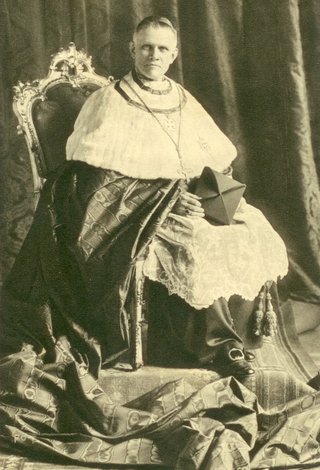Dr. Theodor Kardinal Innitzer

Personalia
Born:
Died:
Profession:
Persecution:
Feast of the Rosary 1938,
Storming of the archbishopric in 1938,
Aid center for non-Aryan Catholics 1938 - 1945
Memberships
Curriculum Vitae
Theodor Innitzer was born the son of a small farmer and factory worker. From 1890 to 1898, he attended grammar school in Kaaden (Kadan) near Eger (Chéb), then entered the Viennese seminary and studied at the Faculty of Theology at the University of Vienna (Dr. theol. 1906). After his ordination to the priesthood on July 25, 1902, he spent a year as chaplain in Pressbaum near Vienna. He then became prefect of studies and, in 1906, sub-rector at the Vienna seminary.
In 1908, Theodor Innitzer habilitated in New Testament Studies at the Vienna Faculty of Catholic Theology. In 1910 he became church rector at the Herz-Jesu-Kloster on Landstraßer Hauptstraße in Vienna, and in October 1913 he was appointed as a university professor. He was dean three times and rector of the university in 1928/29.
During his year as rector, the activities of the National Socialist German Student Union (NSDStB) intensified considerably. Innitzer banned a commemorative event at the university to mark the 5th anniversary of the Hitler Putsch, which was even to be attended by SA leader Ernst Röhm. Six months later, on June 1 and 8, 1929, there are multiple clashes between the NSDStB and Jewish students, whereupon Innitzer bans the wearing of the brown shirt. As a result, the National Socialists launched an agitation against him, accusing him of being a henchman of "Jewish terror".
The student fraternity Nordgau Wien accepted Theodor Innitzer towards the end of his rectorate. In addition to his teaching activities, Theodor Innitzer is involved in the organization of the Eucharistic World Congress in Vienna in 1912. In 1913 he became Secretary General of the Leo Society, and in 1919 he took over the management of St. Thomas College, the former St. Augustine Institute for Priestly Education (Frintaneum). He was also a trustee of the Austrian Pilgrim Hospice in Jerusalem.
In September 1929, Theodor Innitzer was appointed Federal Minister for Social Administration, a position he held until September 1930. On his initiative, the so-called Small Pensioners Act was passed during his term of office. He also worked to reduce unemployment.
On September 19, 1932, Theodor Innitzer was appointed Prince Archbishop of Vienna and Apostolic Administrator of Burgenland by Pope Pius XI as successor to Friedrich Gustav Cardinal Piffl. He was consecrated bishop on October 30, 1932 and created a cardinal in 1933.
Theodor Cardinal Innitzer took office as Archbishop of Vienna and Chairman of the Austrian Bishops' Conference at a time of upheaval in both domestic and foreign policy. Adolf Hitler took power in Germany.
The final phase of the negotiations for a concordat and its conclusion in 1933/34 was also significant in terms of church policy. One of the first highlights of his term of office was the Catholic Congress in September 1933, which was also held to commemorate the liberation of Vienna in 1683. It was conceived as a "General German", i.e. supra-regional Catholic Day, but hardly any Catholics from the German Reich took part due to the so-called "thousand mark ban". In November 1933, the priests were dismissed from their political posts.
Theodor Cardinal Innitzer came under criticism for his visit to Hitler on March 15, 1938 in the Hotel Imperial and, above all, for the bishops' declaration on the Anschluss on March 18. His political guilelessness and the pressure exerted by the National Socialist rulers had a decisive influence on these steps. However, the negative overvaluation of these events cannot be justified scientifically. The Nazis exploited this declaration and the bishops' letter ("Heil Hitler") for propaganda purposes, which deeply unsettled the Catholic core strata.
Theodor Cardinal Innitzer was already served the bill in October 1938. After an unplanned powerful rally by Catholic youth in Vienna's St. Stephen's Cathedral on October 7 ("Rosenkranzfest"), the following day there was a storming of the Archbishop's Palace by HJ and SA troops, during which Theodor Cardinal Innitzer had to flee to safety via an underground passage into St. Stephen's Cathedral, otherwise he would have been killed by the street mob. During the war, Innitzer's establishment of the "Relief Center for Non-Aryan Catholics" was a remarkable initiative that saved the lives of many people.
After the war, Theodor Cardinal Innitzer worked on reconstruction. During his time in office, 50 new parishes were established in the diocese of Vienna. Highlights of this period include the reopening of the renovated St. Stephen's Cathedral in 1952 and an Austrian Catholic Congress in the same year, at which Theodor Cardinal Innitzer acted as Papal Legate. Against his resistance, Innitzer was appointed coadjutor in 1950.
After the war, Theodor Cardinal Innitzer is involved in reconstruction. During his time in office, 50 new parishes were established in the diocese of Vienna. Highlights of this period include the reopening of the renovated St. Stephen's Cathedral in 1952 and an Austrian Catholic Congress in the same year, at which Theodor Cardinal Innitzer acted as Papal Legate. Against his resistance, Innitzer was appointed coadjutor in 1950.
Theodor Cardinal Innitzer died in Vienna at the age of 79.
Places
Citations
Biolex des ÖCV unter www.oecv.at/biolex
